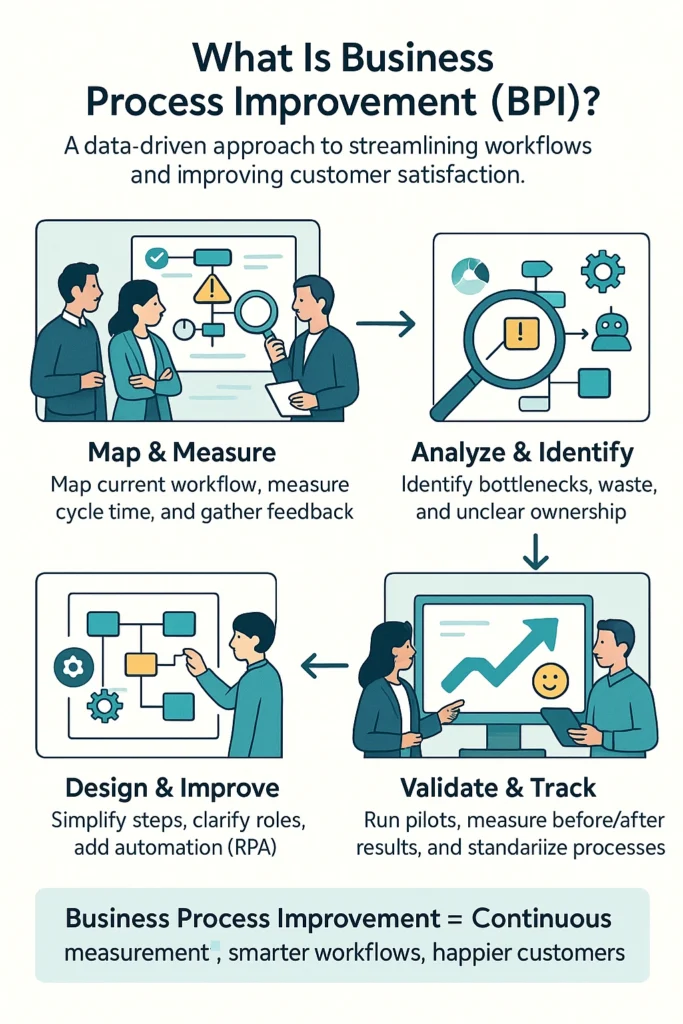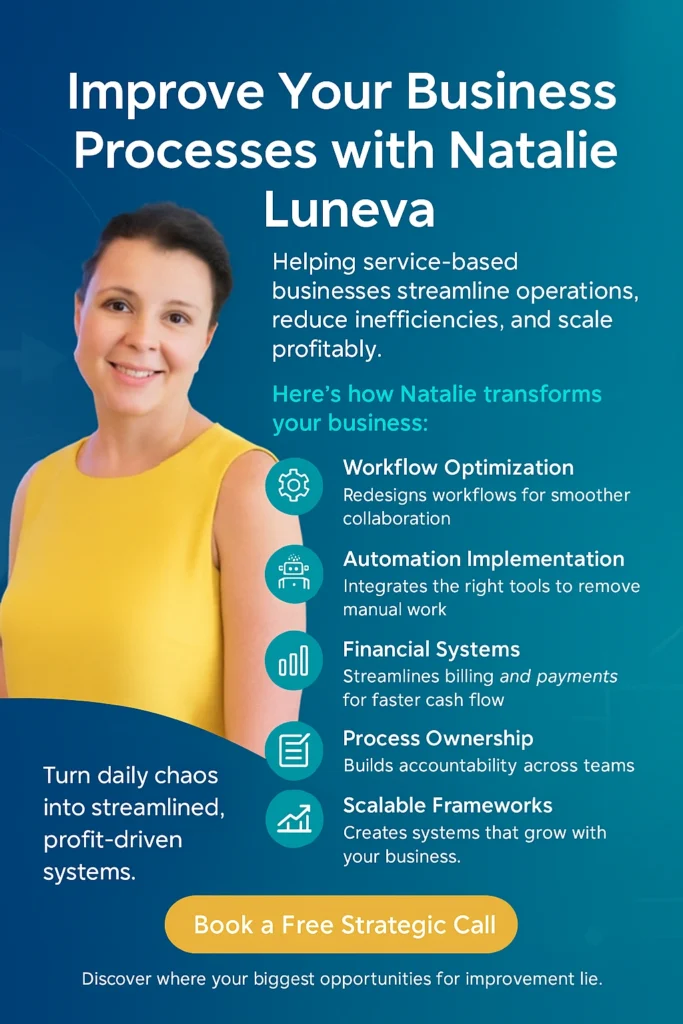Business Process Improvement for service-based businesses is the strategic, ongoing effort to analyze, streamline, and enhance the way services are delivered. It involves mapping out every step of your operational workflow, from the first client inquiry to project delivery and invoicing, then identifying where delays, redundancies, or miscommunications occur. Using data such as cycle times, error rates, or customer feedback, BPI helps you understand where your service delivery slows down or breaks down.
Key Takeaways
- Natalie Luneva helps service-based businesses streamline workflows and eliminate inefficiencies.
- Using data-driven insights, Natalie identifies bottlenecks and opportunities for faster, smoother operations.
- Her hands-on approach maps workflows, uncovers root causes, and implements practical improvements.
- Leveraging automation and analytics, Natalie ensures your processes scale without adding friction.
- With standardized SOPs and continuous oversight, Natalie helps businesses sustain improvements and drive growth.
What is Business Process Improvement?
Begin with a clear map of current work: that map reveals queues, handoffs, and slow steps. Treat this discipline as a practical, data-driven routine that turns observations into targeted fixes.
How BPI identifies bottlenecks, waste, and friction
Visualize each step and measure cycle time, error rates, and customer feedback. Use those numbers to spot where work stalls or repeats.
Run root cause analysis to separate symptoms from true causes, unclear ownership, too many approvals, or tool limits. Then design fixes such as simplifying steps, clarifying roles, reskilling staff, or adding automation like RPA.
Linking processes to customer satisfaction and business goals
Focus changes on fewer errors, faster responses, and clearer communications across the customer journey. That directly lifts customer satisfaction and reduces churn.
Align each change with measurable goals: revenue retention, SLA compliance, or margin lift. Validate solutions via pilots, then track before/after metrics on dashboards so management gains visibility and teams keep gains repeatable.
- Map current workflow and collect data.
- Analyze pain points and run root cause searches.
- Design targeted fixes and validate with pilots.
- Measure results and document standard operating steps.

Business Value: Benefits You Can Realize Today
Tangible gains come fast when you remove needless steps and sharpen handoffs. You can cut costs, eliminate redundant tasks, and free up resources for higher-value work.
You minimize errors with clearer rules, better checks, and selective automation. Fewer mistakes raise quality and boost customer satisfaction.
Speed improves as approvals shrink and cycle times fall. Teams finish requests faster and deliver consistent, reliable outcomes.
- Save money through reduced rework and fewer escalations.
- Raise productivity, remove blockers and streamline daily work.
- Strengthen quality management with measurable criteria at key steps.
| Benefit | Metric | Example action |
| Cost reduction | Lower cost per ticket | Remove duplicate approvals |
| Consistency & compliance | Audit pass rate | Document SOPs and controls |
| Faster results | Cycle time | Automate routing and notifications |
The Step-by-Step Process Improvement Lifecycle
Pick a single high-impact workflow that affects customers or costs and get stakeholders aligned. Clarify scope, goals, and limits so your team focuses on a measurable target.
Next, map current steps and collect data like cycle time, error rates, and customer feedback. Use that data for focused analysis that spots queues, rework, and handoffs.
Run root cause workshops to isolate the real issues. Then design several changes, test them in a pilot, and rank options by impact and ease of adoption.
- Create an action plan with tasks, owners, timelines, resources, and success criteria so teams can execute with clarity.
- Implement using clear change management and training so new routines stick across shifts and locations.
- Measure KPIs, cycle time, first-contact resolution, backlog, error rate, and standardize wins with SOPs.
- Schedule periodic reviews to sustain continuous gains and share lessons to build organizational knowledge.
| Lifecycle Phase | Key Metric | Typical Owner | Quick Action |
| Identify & Scope | Customer impact score | Service lead | Define boundaries and success criteria |
| Map & Measure | Cycle time, error rate | Process analyst | Capture steps and collect data |
| Design & Pilot | Projected time saved | Improvement owner | Run small test and gather feedback |
| Implement & Standardize | SLA compliance, FCR | Operations manager | Train teams and publish SOPs |
Tools and Techniques: From Mapping to Value Streams
Choose simple visual tools that expose handoffs, delays, and roles so teams can act fast. Use those tools to set clear boundaries before diving into details.
Business process mapping and SIPOC for clarity
Use a SIPOC diagram to name suppliers, inputs, main steps, outputs, and customers. Then expand that view into a detailed map that shows each task, role, and system.
Value stream mapping to visualize end-to-end value delivery
Apply value stream mapping to trace the full value stream and display queues, rework loops, and non‑value steps. Quantify delays and handoffs so you can target the largest gains first.
Kanban boards to manage work-in-progress and flow
Deploy Kanban to limit work in progress, expose bottlenecks, and make status visible. Integrate metrics, cycle time, throughput, backlog age, so issues trigger immediate action.
- Standardize mapping conventions so teams produce comparable diagrams.
- Link outputs to a prioritized backlog with clear owners and timelines.
- Make tools part of daily management, not one-off workshops.
| Tool | Main use | Key metric |
| SIPOC | Frame boundaries and stakeholders | Clarity of inputs/outputs |
| Detailed mapping | Expose steps, roles, systems | Error causes & handoff count |
| Value stream mapping | Visualize end-to-end flow | Total lead time & non-value % |
| Kanban | Manage WIP and flow | Cycle time & WIP levels |
Technology’s Role: Automation, Analytics, and Digital Transformation
Technology improves the operational business processes, turning manual steps into fast, traceable work. You gain speed, lower error rates, and clearer data so teams can act with confidence.
Automation and low/no-code
Deploy automation and low/no-code tools to digitize repetitive tasks. This boosts efficiency and raises productivity without heavy IT projects.
Advanced analytics
Use analytics to move beyond reports and toward prediction. Trend analysis flags demand spikes and risk signals so you can allocate resources ahead of time.
Monitoring, control, and collaboration
Real-time sensors and dashboards give managers instant visibility. Combine alerts with cloud platforms to align distributed teams and speed approvals.
System integration
Link disparate systems so data flows end-to-end. Integration removes rekeying, reduces silos, and helps your organization adapt to market changes.
- Standardize event logs to measure gains and support continuous improvement.
- Roll out changes in small releases so teams learn and adjust quickly.
- Prioritize tools that improve management visibility and auditability.
| Tool | Main benefit | Key metric |
| Low/no-code | Fast workflow automation | Cycle time |
| Analytics platform | Predictive alerts | Forecast accuracy |
| Integration hub | Seamless data flow | Hand-off count |
Service-Based Use Cases, Metrics, and Results
Tailored onboarding flows and smart scheduling turn common friction into measurable gains. Use segment-aware journeys to deliver only relevant content and automate follow-ups with BPM-driven workflows.
Customer onboarding: Personalization and BPM-driven workflows
You personalize onboarding to avoid overload, tailoring steps by segment and automating delivery. Track onboarding cycle time, completion rate, and early product adoption to prove results against goals.
Customer support and ticket resolution: Reducing cycle time and errors
Apply clear triage rules, Kanban boards, and automation to cut cycle time and lower error rates. Monitor first-contact resolution, average handle time, and backlog age to manage daily performance.
Field and professional services: Scheduling, SLAs, and utilization
Use dynamic scheduling, route optimization, and SLA tracking to boost utilization and on-time rates. Align dispatch rules with priority tiers so teams hit commitments and reduce repeat visits.
KPIs that matter
- Cycle time: time per request to completion.
- First-contact resolution: reduce repeat contacts and failure demand.
- Customer satisfaction and throughput: tie these metrics to strategic goals.
- Error rate and backlog age: surface upstream fixes with cohort analysis.
| Use case | Key metric | Quick action |
| Onboarding | Completion rate | Segmented BPM flows |
| Support | FCR & cycle time | Kanban + automation |
| Field services | Utilization & SLA | Dynamic scheduling |
Overcoming Challenges and Sustaining Continuous Improvement
Sustaining gains demands a clear governance model, steady funding, and ongoing measurement. Name owners and giving them authority to act. That prevents drift and keeps teams accountable.
Handle resistance and invite staff early. Explain the why and co-design solutions so changes make daily work easier. Use quick pilots to show wins and build trust.
Aligning efforts with strategy and compliance
Map each initiative to organizational goals and regulatory rules. That alignment ensures every change advances goals and meets obligations within organization policies.
Resourcing, governance, and ongoing measurement
Assign clear governance, tie process management to accountable leaders, and fund projects appropriately. Provide tools and systems that support adoption.
- Right-size the methodology and approach to the risk and scope.
- Run structured training, communication plans, and rapid feedback loops.
- Track leading and lagging metrics to detect drift and trigger fixes.
| Challenge | Action | Owner | Success metric |
| Resistance from teams | Co-design sessions and pilots | Change lead | Adoption rate |
| Misalignment with goals | Goal mapping and compliance checks | Operations director | Goal alignment score |
| Insufficient resources | Budget and tool allocation | Finance & PMO | Staffing & tool readiness |
| Loss of gains over time | Regular audits and recognition | Process owner | Retention of metrics |
Improve Your Business Processes with Natalie Luneva
If your service-based business is struggling with inefficiencies, missed opportunities, or growing pains as you scale, Natalie Luneva helps you turn disorganized operations into streamlined, profit-driven systems. With over a decade of experience in operations, marketing, and business strategy, Natalie works hands-on to simplify and optimize your core processes, so you can focus on growth instead of daily chaos.
Here’s how Natalie helps service-based businesses improve their operations:
- Workflow Optimization: Identifies inefficiencies and redesigns workflows for smoother operations and better collaboration.
- Automation Implementation: Introduces the right tools and systems to eliminate repetitive manual work and improve accuracy.
- Financial and Invoicing Systems: Streamlines billing, payments, and reporting to ensure faster cash flow and fewer errors.
- Process Ownership: Establishes accountability across teams, ensuring everyone knows their role in delivering consistent service.
- Scalable Frameworks: Builds operational systems that grow with your business, reducing bottlenecks and supporting long-term success.
The result is a more efficient, reliable, and scalable business that runs smoothly behind the scenes, freeing you to focus on delivering exceptional client experiences and driving growth. Book a free discovery call with Natalie today to uncover where your biggest opportunities for improvement lie and start transforming your business processes.

Conclusion
Business Process Improvement is a strategic approach that transforms how service-based businesses operate. When you map workflows, identify bottlenecks, and apply targeted solutions, you can reduce errors, speed up delivery, and elevate the customer experience.
When combined with automation, analytics, and standardized procedures, these improvements become repeatable and scalable, enabling your team to work smarter, not harder. Whether you’re streamlining onboarding, optimizing support, or improving field service operations, BPI gives you measurable results and sustainable gains.
Partnering with an expert like Natalie Luneva ensures your business processes are not only optimized but aligned with your growth goals, book a discovery call today to start transforming your operations.
FAQs
How long does it typically take to see results from Business Process Improvement?
The timeline varies depending on workflow complexity, team size, and technology adoption. Some quick wins like automation or clarifying roles can show improvements in weeks, while larger systemic changes may take several months to fully implement and standardize.
Can small service-based businesses benefit from BPI?
Absolutely. Even small teams gain efficiency and consistency through mapping processes, reducing redundancies, and introducing simple tools like Kanban boards or automation, which scale as the business grows.
How often should processes be reviewed for improvement?
Processes should be reviewed regularly, quarterly or semi-annually is common. High-volume or critical workflows may need monthly monitoring to ensure continued efficiency and identify new bottlenecks.
Can BPI be applied to client-facing and back-office processes equally?
Yes. BPI applies to both front-end service delivery (like customer onboarding and support) and back-office operations (like invoicing or resource allocation). Each benefits from reduced errors, faster execution, and improved consistency.
What are common obstacles to successful BPI?
Typical challenges include employee resistance, lack of clear ownership, insufficient data, or inadequate tools. Addressing these with co-design, training, and leadership support ensures lasting improvements.
Can improvements be sustained long-term?
Yes. Sustaining gains requires regular monitoring, clear governance, continuous training, and periodic process audits. Standard operating procedures and KPIs help teams maintain improvements over time.


